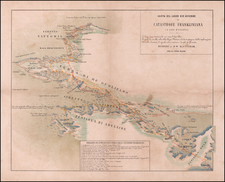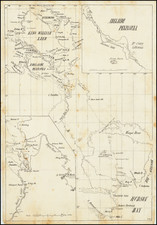Search
Klutschak was an Austrian adventurer, author, illustrator and participant of Frederick Schwatka's expedition on search of John Franklin.
In 1877 Klutschak was a passenger on the schooner Flying Fish on a seal hunt in the South Atlantic. The ship reached the island of South Georgia on September 22, 1877. By February 28, 1878, the ship had completed a circumnavigation the island, allowing him to make a map of South Georgia, which he later published together with a report in the German Review of Geography and Statistics. Klutschak's observations were of great interest, covering both geography and animal life.
After returning, he next participated in the Shwatka Expedition. A number of whalers working the arctic regions reported that documents of the lost John Franklin were located on King William Island. The editor of the New York Herald, James Gordon Bennett, then decided to equip a privately funded land expedition to seek these documents. He was supported by Charles P. Daly (1816-1899), the president of the American Geographical Society, as well as several companies. The leader of the expedition, Lieutenant Frederick Schwatka. Klutschak took part in the expedition as a draftsman and cartographer.
The expedition left New York on June 17, 1878 aboard the schooner Eothen and settled in early August north of the Chesterfield Inlet on the west coast of Hudson Bay. Here, the men lived for eight months under the Aivilingmiut and adopted their way of life, including eating habits and hunting and traveling techniques. On April 1, 1879, they set off on land in the direction of King William Island, accompanied by 13 Inuit dogs. In June, they reached the Simpson Strait, where the base camp was established. Klutschak, Schwatka, Gilder, Melms the hunter Tulugaq with his family began to carefully search the shores of the Adelaide Peninsula and King William Islands for traces of the Franklin expedition. Ebierbing and the remaining Inuit remained in the camp to hunt and fish. In August, the search team split into two groups, one headed by Klutschak, the other Schwatka.
The expedition was the first in the history of polar research to fully utilize Inuit techniques. In 11.5 months, over 3000 miles were covered with dog sleds. There were no serious injuries or illnesses, and the diet of fresh meat saved the participants from scurvy. No papers of Franklin were found, but numerous relics of his crew and the two ships HMS Terror and HMS Erebus were located. Kluchak and his companions found the remains of 15 to 30 men of the Franklin expedition and buried them. Klutschak's special contribution was the discovery of the skeletons in Starvation Cove, which Schwatka had previously overlooked because of acculumated snow.
Heinrich Klutschak described his travel experiences in 1881 in his book, Als Eskimo unter den Eskimos. His report differs from those of Schwatka and Gilders mainly in that his main focus is not on the search for Franklin's papers, but on the description of the life of the Inuit. It is an early ethnographic work of great value and was an important source for Franz Boas' famous book The central Eskimo of 1888. Klutschak's book initially appeared only in German, an English translation was published in 1993 under the title Overland to Starvation Cove: with the Inuit in search of Franklin 1878–1880.
In the early 1880s, Klutschak also published a number of smaller works on topics of geography and polar research. He also provided the illustrations for a multi-part report on Schwatka Expedition in the Illustrated London News. Through Austria and Germany he toured with a lecture about his experiences, which also visited the Austrian Emperor Franz Joseph I


